Refined Assessment and Future Projections of Indian Summer Monsoon Rainfall Using CMIP6 Models
Abstract
:1. Introduction
2. Data and Methods
2.1. Data
2.2. Methods
3. Results
3.1. Assessment of CMIP6’s Historical Simulation Capabilities for the ISMR
3.1.1. Evaluation for Spatial Variation
3.1.2. Evaluation for Interannual Variability
3.1.3. Evaluation for Overall Competence
3.2. Exploring Potential Causes for Biases in ISMR Simulations by CMIP6 Models
3.2.1. Discrepancies between Prime and Nonperforming Models
3.2.2. Investigating the Role of Sea Surface Temperature Anomalies in Modulating the ISMR
3.2.3. Assessing the Contributions of Atmospheric Circulation Dynamics to ISMR Variability
3.3. Anticipated Shifts in ISMR: Insights from CMIP6 Projections
4. Discussion
5. Conclusions
- (1)
- A significant portion of the CMIP6 models adeptly encapsulate the climatological nuances of ISMR. However, there is a propensity to overemphasize the precipitation intensity over the Western Ghats while underrepresenting it in India’s central and eastern regions. The interannual variability simulated by these models exhibits a marked divergence from actual observations. While certain models shine in either climatology or interannual variability, a tangible correlation between these two performance metrics remains elusive. After a comprehensive assessment, models that best capture the spatiotemporal variations of ISMR include BCC-ESM1, EC-Earth3-Veg, GFDL-CM4, INM-CM5-0, and SAM0-UNICON.
- (2)
- The pMME’s prowess in simulating ISMR’s climatology is distinctly superior to that of both the MME and nMME. This is particularly evident in the portrayal of the southwest monsoon’s vigor and the precipitation patterns over central and eastern India. An in-depth analysis ascertains that the Northern Indian Ocean’s (NIO) spring SST cold bias is a cardinal element affecting the precision of ISMR simulations. The enhanced acumen of pMME in simulating diverse atmospheric circulation facets is instrumental in the accurate depiction of ISMR’s climatology.
- (3)
- As we approach the twilight of the 21st century, projections indicate an uptick in ISMR across all three emission trajectories, with the surge under the SSP5-8.5 scenario being markedly more accentuated than its SSP1-2.6 and SSP2-4.5 counterparts. All three model ensembles anticipate a more pronounced percentage augmentation in precipitation in northern India relative to the southern regions, and a more substantial increase in the west than the east. Intriguingly, the nMME’s projected percentage escalation for ISMR considerably outstrips the projections of both MME and pMME. These revelations underscore the profound ramifications of varying emission scenarios on ISMR’s future trajectories, furnishing invaluable insights for the formulation of climate-centric policies.
Author Contributions
Funding
Data Availability Statement
Acknowledgments
Conflicts of Interest
References
- Saha, K.R.; Mooley, D.A.; Saha, S. The Indian monsoon and its economic impact. Geojournal 1979, 3, 171–178. [Google Scholar] [CrossRef]
- Gusain, A.; Ghosh, S.; Karmakar, S. Added value of CMIP6 over CMIP5 models in simulating Indian summer monsoon rainfall. Atmos. Res. 2019, 232, 104680. [Google Scholar] [CrossRef]
- Jiang, W.H.; Chen, H.P. Simulation and projection of extreme temperature changes in the mid-high latitudes of Asia by CMIP6 models. Trans. Atmos. Sci. 2021, 44, 592–603. (In Chinese) [Google Scholar]
- Song, Y.J.; Li, X.F.; Bao, Y.; Song, Z.; Wei, M.; Shu, Q.; Yang, X. FIO-ESM v2.0 Outputs for the CMIP6 Global Monsoons Model Intercomparison Project Experiments. Adv. Atmos. Sci. 2020, 37, 1045–1056. [Google Scholar] [CrossRef]
- Wang, Z.Q.; Li, G.; Yang, S. Origin of Indian summer monsoon rainfall biases in CMIP5 multimodel ensemble. Clim. Dyn. 2018, 51, 755–768. [Google Scholar] [CrossRef]
- Sperber, K.R.; Annamalai, H.; Kang, I.S.; Kitoh, A.; Moise, A.; Turner, A.; Wang, B.; Zhou, T. The Asian summer monsoon: An intercomparison of CMIP5 vs. CMIP3 simulations of the late 20th century. Clim. Dyn. 2013, 41, 2711–2744. [Google Scholar] [CrossRef]
- Boos, W.R.; Hurley, J.V. Thermodynamic bias in the multimodel mean boreal summer monsoon. J. Clim. 2013, 26, 2279–2287. [Google Scholar] [CrossRef]
- Levine, R.C.; Turner, A.G.; Marathayil, D.; Martin, G.M. The role of northern Arabian Sea surface temperature biases in CMIP5 model simulations and future projections of Indian summer monsoon rainfall. Clim. Dyn. 2013, 41, 155–172. [Google Scholar] [CrossRef]
- Jiang, Z.H.; Li, W.; Xu, J.J.; Li, L. Extreme Precipitation Indices over China in CMIP5 Models. Part I: Model Evaluation. J. Clim. 2015, 28, 8603–8619. [Google Scholar] [CrossRef]
- Srerkala, P.P.; Babu, C.A.; Rao, V.B. On the simulation of northeast monsoon rainfall over southern peninsular India in CMIP5 and CMIP6 models. Theor. Appl. Climatol. 2022, 150, 969–986. [Google Scholar] [CrossRef]
- Guo, P.W.; Shen, C.; Dong, L.N.; Zhang, P.Q.; Yin, L.W. Observational analysis and simulation assessment of sea-land thermal changes in the Asian monsoon region. Trans. Atmos. Sci. 2017, 40, 215–223. (In Chinese) [Google Scholar]
- Turner, A.G.; Annamalai, H. Climate change and the South Asian summer monsoon. Nat. Clim. Chang. 2012, 2, 587–595. [Google Scholar] [CrossRef]
- Woo, S.; Singh, G.P.; Oh, J.H.; Lee, K.-M. Projection of seasonal summer precipitation over Indian sub-continent with a high-resolution AGCM based on the RCP scenarios. Meteorol. Atmos. Phys. 2019, 131, 897–916. [Google Scholar] [CrossRef]
- Jayasankar, C.B.; Surendran, S.; Rajendran, K. Robust signals of future projections of Indian summer monsoon rainfall by IPCC AR5 climate models: Role of seasonal cycle and interannual variability. Geophys. Res. Lett. 2015, 42, 3513–3520. [Google Scholar] [CrossRef]
- Si, S.; Bi, X.Q.; Kong, X.H.; Hua, W. Analysis of the spatiotemporal distribution characteristics of major greenhouse gases and aerosol emissions intensity in CMIP6 scenarios. Clim. Environ. Res. 2020, 25, 366–384. (In Chinese) [Google Scholar]
- Eyring, V.; Bony, S.; Meehl, G.A.; Senior, C.A.; Stevens, B.; Stouffer, R.J.; Taylor, K.E. Overview of the Coupled Model Intercomparison Project Phase 6 (CMIP6) experimental design and organization. Geosci. Model Dev. 2016, 9, 1937–1958. [Google Scholar] [CrossRef]
- He, L.Q.; Zhou, T.J.; Chen, X.L. South Asian summer rainfall from CMIP3 to CMIP6 models: Biases and improvements. Clim. Dyn. 2022, 61, 1049–1061. [Google Scholar] [CrossRef]
- Ha, K.J.; Moon, S.; Timmermann, A.; Kim, D. Future changes of summer monsoon characteristics and evaporative demand over Asia in CMIP6 simulations. Geophys. Res. Lett. 2020, 47, e2020GL087492. [Google Scholar] [CrossRef]
- Almazroui, M.; Saeed, S.; Saee, F.; Islam, M.N.; Ismail, M. Projections of Precipitation and Temperature over the South Asian Countries in CMIP6. Earth Syst. Environ. 2020, 4, 297–320. [Google Scholar] [CrossRef]
- Liu, J.; Wang, B.; Kuang, X.; Soon, W.; Zorita, E. Centennial variations of the global monsoon precipitation in the last millennium: Results from ECHO-G model. J. Clim. 2009, 22, 2356–2371. [Google Scholar] [CrossRef]
- Li, R.Q.; Lü, S.H.; Han, B. Simulation of the Austral-Asian monsoon circulation and its variability by 10 CMIP5 models. J. Trop. Meteorol. 2013, 29, 749–758. (In Chinese) [Google Scholar]
- Taylor, K.E. Summarizing multiple aspects of model performance in a single diagram. J. Geophys. Res. Atmos. 2001, 106, 7183–7192. [Google Scholar] [CrossRef]
- Schuenemann, K.C.; Cassano, J.J. Changes in synoptic weather patterns and Greenland precipitation in the 20th and 21st centuries: 2. Analysis of 21st century atmospheric changes using self-organizing maps. Clim. Dyn. 2010, 115, D05108. [Google Scholar] [CrossRef]
- Chen, W.L.; Jiang, Z.; Li, L. Probabilistic projections of climate change over China under the SRES A1B scenario using 28 AOGCMs. J. Clim. 2011, 24, 4741–4756. [Google Scholar] [CrossRef]
- Liu, Z.; Bollasina, M.A.; Wilcox, L.J.; Rodríguez, J.M.; Regayre, L.A. Contrasting the role of regional and remote circulation in driving Asian monsoon biases in MetUM GA7.1. J. Geophys. Res. Atmos. 2021, 126, e2020JD034342. [Google Scholar] [CrossRef]
- Hanf, F.S.; Annamalai, H. Systematic errors in South Asian monsoon precipitation: Process-based diagnostics and sensitivity to entrainment in NCAR models. J. Clim. 2020, 33, 2817–2840. [Google Scholar] [CrossRef]
- Choudhury, B.A.; Rajesh, P.V.; Zahan, Y.; Goswami, B.N. Evolution of the Indian summer monsoon rainfall simulations from CMIP3 to CMIP6 models. Clim. Dyn. 2022, 58, 2637–2662. [Google Scholar] [CrossRef]
- Mahendra, N.; Chowdary, J.S.; Darshana, P.; Sunitha, P.; Parekh, A.; Gnanaseelan, C. Interdecadal modulation of interannual ENSO-Indian summer monsoon rainfall teleconnections in observations and CMIP6 models: Regional patterns. Int. J. Climatol. 2021, 41, 2528–2552. [Google Scholar] [CrossRef]
- Yu, T.; Chen, W.; Gong, H.; Feng, J.; Chen, S. Comparisons between CMIP5 and CMIP6 models in simulations of the climatology and interannual variability of the east Asian summer Monsoon. Clim. Dyn. 2023, 60, 2183–2198. [Google Scholar] [CrossRef]
- Rajendran, K.; Surendran, S.; Varghese, S.J.; Sathyanath, A. Simulation of Indian summer monsoon rainfall, interannual variability and teleconnections: Evaluation of CMIP6 models. Clim. Dyn. 2022, 58, 2693–2723. [Google Scholar] [CrossRef]
- Chowdary, J.S.; Bandgar, A.B.; Gnanaseelan, C.; Luo, J.-J. Role of tropical Indian Ocean air–sea interactions in modulating Indian summer monsoon in a coupled model. Atmos. Sci. Lett. 2015, 16, 170–176. [Google Scholar] [CrossRef]

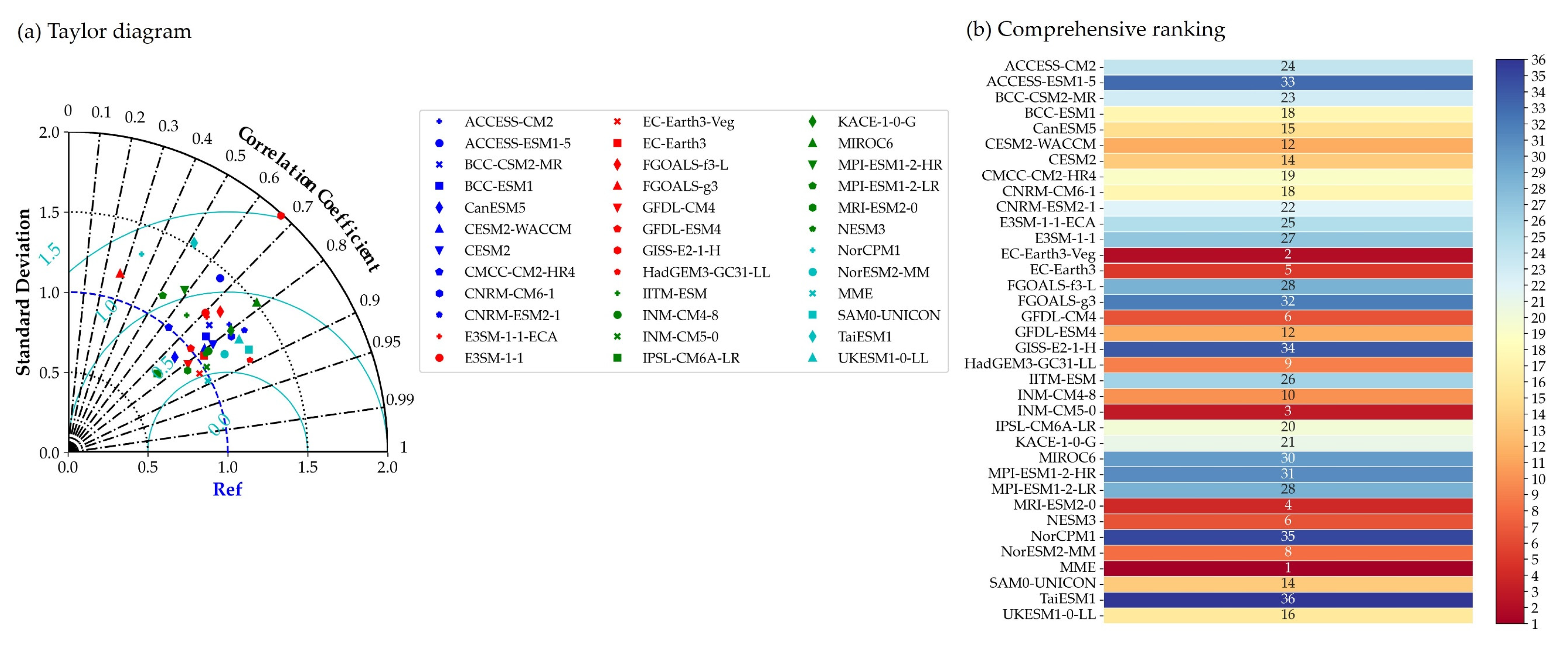
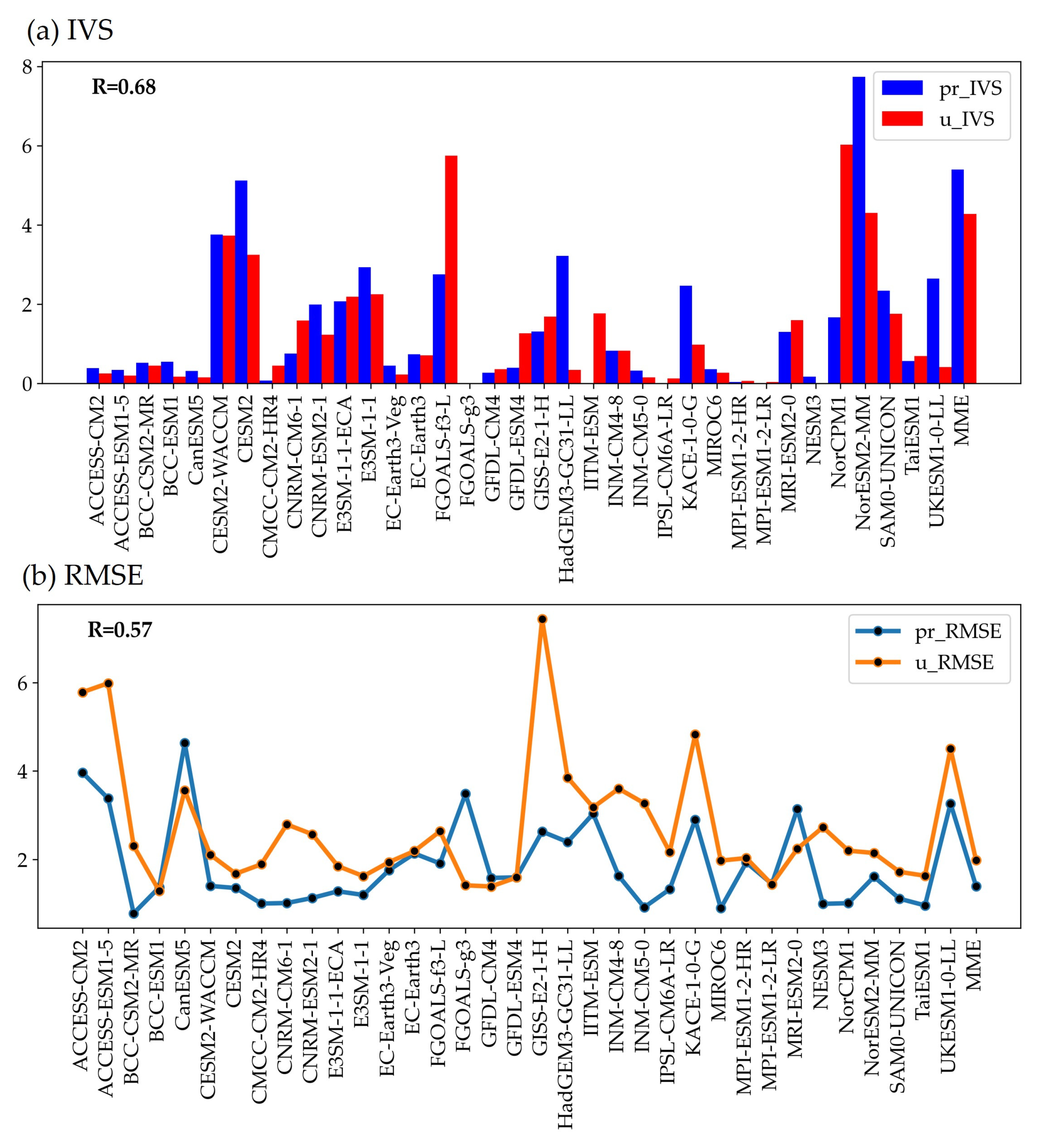
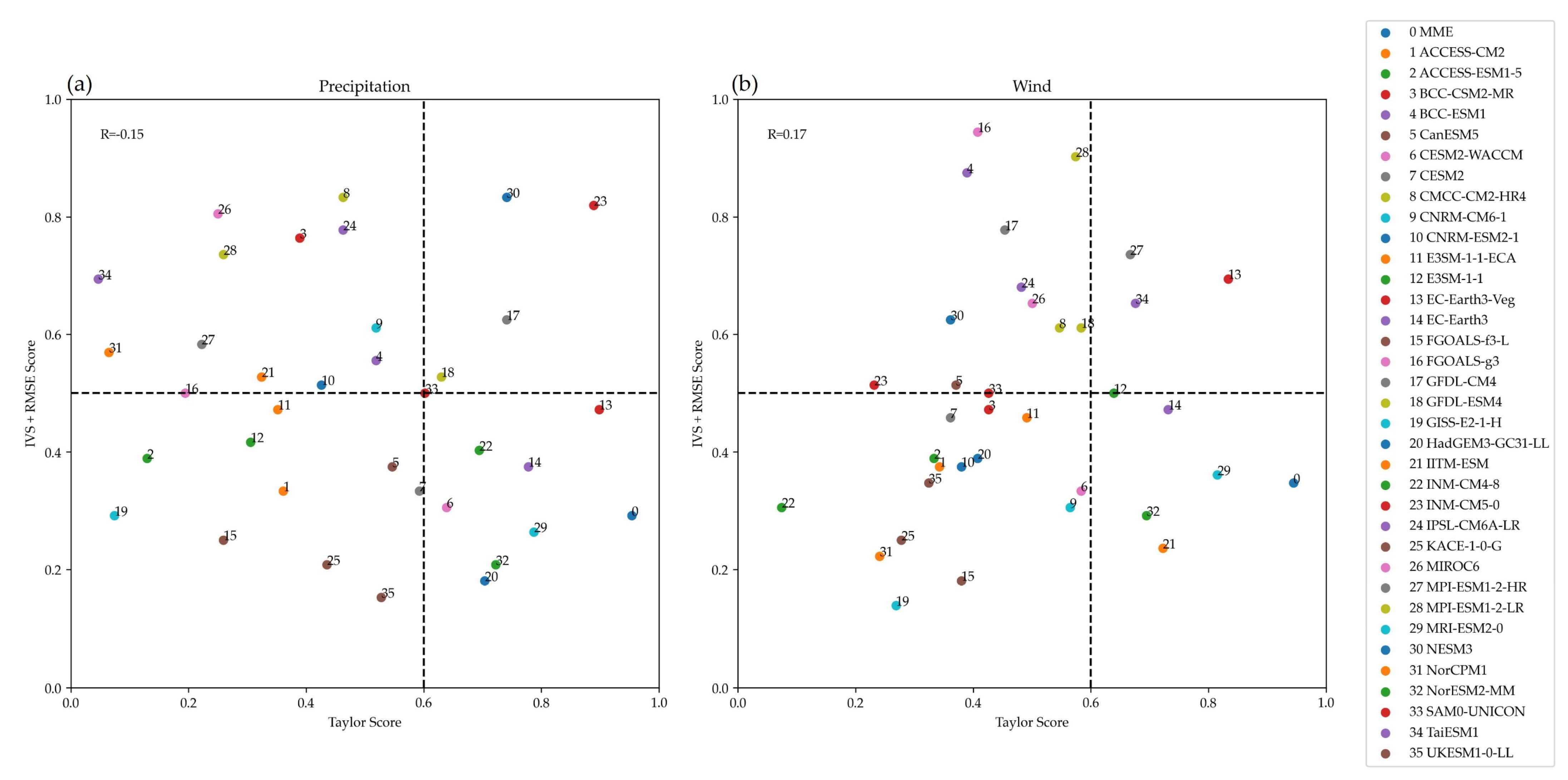


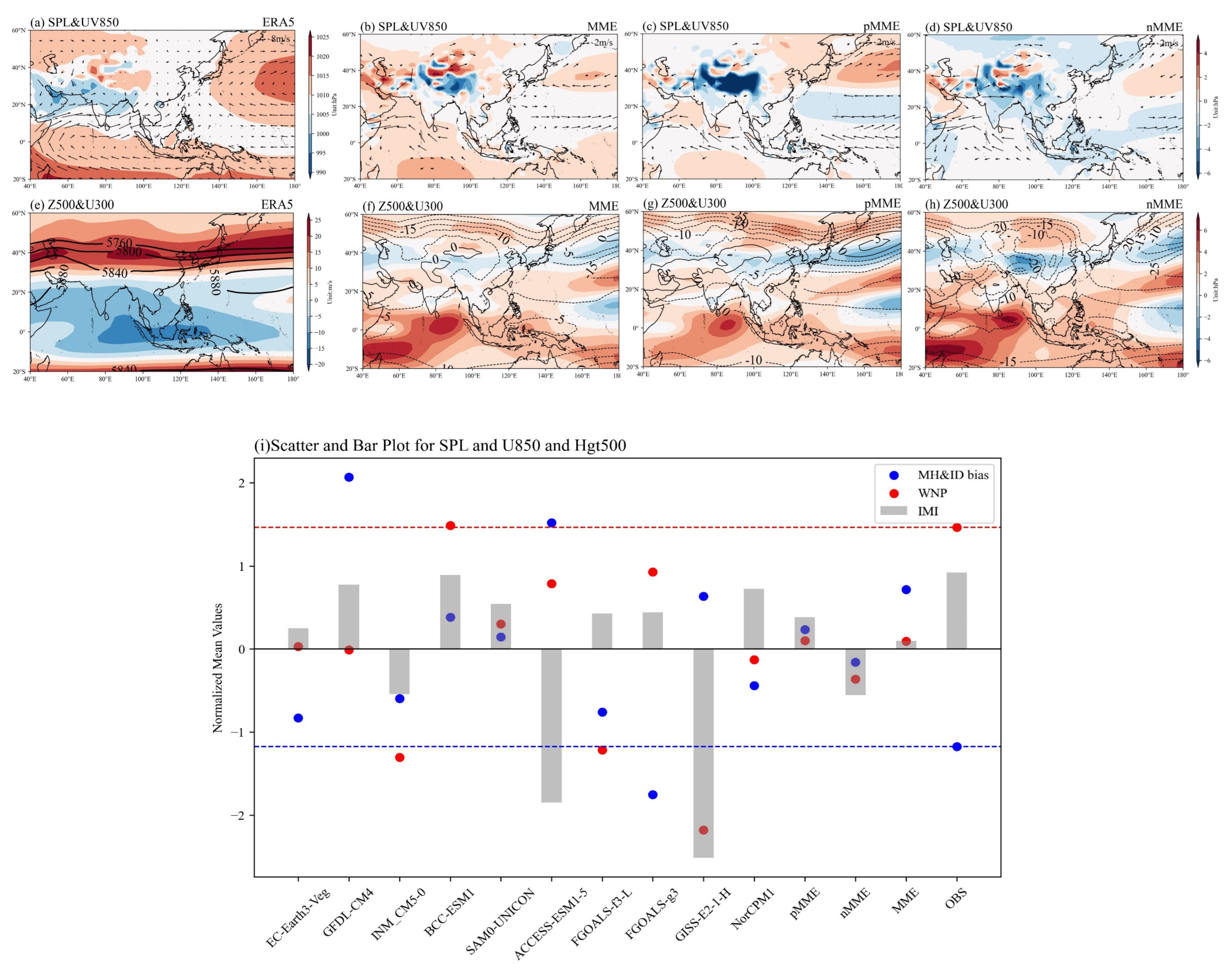
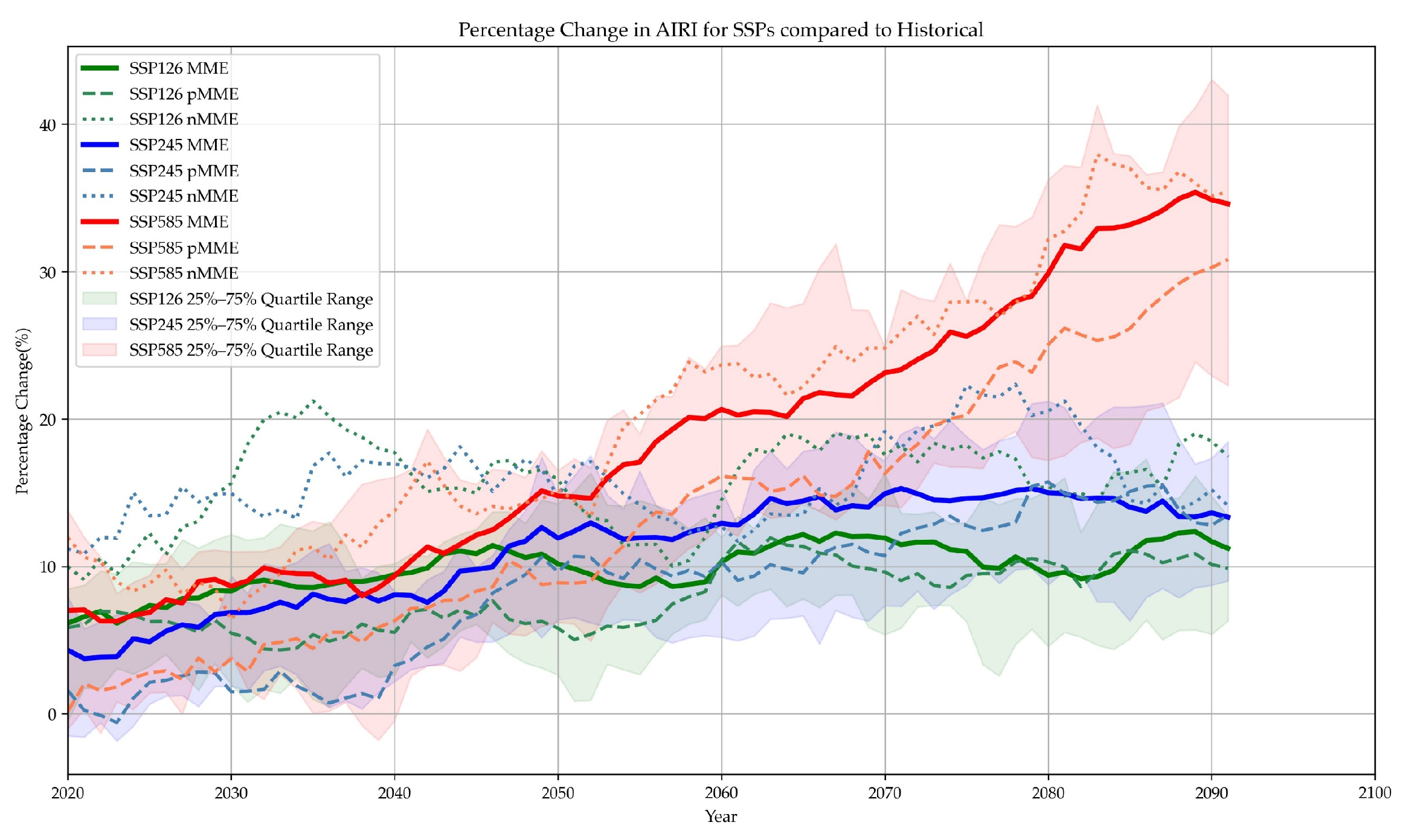
Disclaimer/Publisher’s Note: The statements, opinions and data contained in all publications are solely those of the individual author(s) and contributor(s) and not of MDPI and/or the editor(s). MDPI and/or the editor(s) disclaim responsibility for any injury to people or property resulting from any ideas, methods, instructions or products referred to in the content. |
© 2023 by the authors. Licensee MDPI, Basel, Switzerland. This article is an open access article distributed under the terms and conditions of the Creative Commons Attribution (CC BY) license (https://creativecommons.org/licenses/by/4.0/).
Share and Cite
Li, J.; Fan, L.; Chen, X.; Lin, C.; Song, L.; Xu, J. Refined Assessment and Future Projections of Indian Summer Monsoon Rainfall Using CMIP6 Models. Water 2023, 15, 4305. https://doi.org/10.3390/w15244305
Li J, Fan L, Chen X, Lin C, Song L, Xu J. Refined Assessment and Future Projections of Indian Summer Monsoon Rainfall Using CMIP6 Models. Water. 2023; 15(24):4305. https://doi.org/10.3390/w15244305
Chicago/Turabian StyleLi, Jiahao, Lingli Fan, Xuzhe Chen, Chunqiao Lin, Luchi Song, and Jianjun Xu. 2023. "Refined Assessment and Future Projections of Indian Summer Monsoon Rainfall Using CMIP6 Models" Water 15, no. 24: 4305. https://doi.org/10.3390/w15244305
APA StyleLi, J., Fan, L., Chen, X., Lin, C., Song, L., & Xu, J. (2023). Refined Assessment and Future Projections of Indian Summer Monsoon Rainfall Using CMIP6 Models. Water, 15(24), 4305. https://doi.org/10.3390/w15244305






